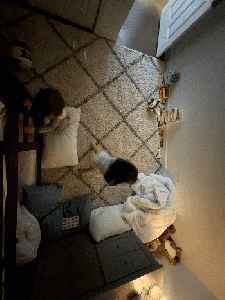The two-year-old chases the three-year-old around the front yard.
—
7 million years ago, some ape ancestor decided walking on two limbs was better than four—maybe to spot predators, maybe just to free up his hands. We don’t know why. He didn’t leave a note.
Today, walking still isn’t natural for humans. A horse, a donkey, a baby giraffe… they just plop out and amble along almost as soon as they hit the ground. But humans take longer. We roll, then crawl. We lean, then stand. After maybe a dozen months we finally get the confidence to put one foot in front of another and take our first steps.
And we fall.
Walking itself is sort of an act of falling: we push our bodies out past our base, tipping ourselves over while each leg catches us in turn.
Nobody teaches a baby to walk. Nobody tells the baby, “good balancing, now pivot your hip, pick up your knee, flex your toes, plant your foot in front—but not too far in front—of your other foot.” Nevertheless, for 7 million years generations of babies have learned to walk.
Babies see their parents walking. Babies get frustrated with crawling. Babies climb up and put one foot out in front of the other.
And babies fall.
Not in the way that walking is falling and catching yourself with alternating legs. Babies fall and they land on their hands and knees, or shoulders and faces. Toddling babies toddle over. Over and over again. Attentive parents pick them up and comfort them (we’re not monsters), but the process of learning to walk is the process of learning to fall. And soon the baby falls less and less. And soon the baby walks more and more. And one day the baby walks all by himself, all the time, and it’s remarkable how unremarkable it is.
—
I think about this watching the two-year-old chase the three-year-old.
The yard slopes. The ground’s uneven. How do they know where to plant their feet?
Their paths form concentric circles in the yard, like planets around some invisible sun. Suddenly it’s not clear who’s chasing who. They cut smaller and smaller circles as each one races to overtake the other. Their orbits spiral toward the center. With each revolution, they lean tighter and tighter into their turns.
Then the three-year-old leans too far. His foot slips. He trusted the uneven ground too much.
Now his arm is scraped. There’s some blood. I pick him up off the ground and comfort him. He buries his sobbing face in my shoulder.
—
I want my kids to fall.
I want them to fall often.
I want them to not be afraid of falling.
There are things they can only learn from falling. As much as I want to reduce their pain—break lessons into parts, guide them step-by-step—some things can only be learned by doing. Unsuccessfully at first, then successfully.
I’ll be there to comfort them when they need it (I’m not a monster).
But I know they have to fall down to grow up. I know they have to fall over and over again, then learn to catch themselves.
So I’m going to let them fall. This is my note explaining why.

Over and over again

Cute story. Funny how so many just assume evolution is true and weave it into their lives. It’s very plausible that it’s not true and your all just practicing continuation bias.
LikeLike